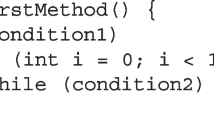Abstract
Understanding, an internal process of human beings, is difficult to measure but not impossible. Therefore attempts have been made to measure the understandability of software system in terms of its complexity. Understandability of source code can be measured in terms of its cognitive complexity which is also called psychological complexity. This paper presents a metrics for measuring understandability of a class integral to Object Oriented Software System. The manuscript proposes metrics for measuring cognitive complexity of class due to its attributes. The proposed metrics takes into consideration the complexity introduced by data types of attributes that forms data elements of a class. The primitive, system defined and user-defined data types, used for defining the attributes have been weighted to measure the cognitive complexity of a class. Also an empirical study has been performed to gain insight on the correlation between the proposed measure and the understandability of the program. The results show the significance of measuring contribution of attributes towards cognitive complexity of a class. A metrics meant to measure cognitive complexity of a class should consider weighted measure of complexity introduced by different attributes of a class.











Similar content being viewed by others
References
Atkinson DC, Griswold WG (1998) Effective whole-program analysis in the presence of pointers. In: Proceedings of the 6th ACM SIGSOFT international symposium on foundations of software engineering, SIGSOFT ’98/FSE-6, pp 46–55, New York, NY, USA, ACM
Bandi RK, Vaishnavi VK, Turk DE (2003) Predicting maintenance performance using object-oriented design complexity metrics. IEEE Trans Softw Eng 29:77–87
Bastani FB, Iyengar SS (1987) The effect of data structures on the logical complexity of programs. Commun ACM 30:250–259
Bennett KH, Cornelius BJ, Munro M, Robson DJ (1988) Software maintenance: a key area for research. Univ Comput
Boehm BW, Brown JR, Lipow M (1976) Quantitative evaluation of software quality. In: Proceedings of the 2nd international conference on software engineering, ICSE ’76, pp 592–605, Los Alamitos, CA, USA, 1976 IEEE Computer Society Press
Booch G (1986) Object-oriented development. IEEE Trans Softw Eng 12:211–221
Bradley JT (2003) An examination of aspect-oriented programming in industry. Technical report
Briand LC, Daly JW, Wüst JK (1999) A unified framework for coupling measurement in object-oriented systems. IEEE Trans Softw Eng 25:91–121
Cant SN, Ross Jeffery D, Brian H-S (1995) A conceptual model of cognitive complexity of elements of the programming process. Inf Softw Technol 37(7):351–362
Chhabra JK, Aggarwal KK, Yogesh S (2003) Code and data spatial complexity: two important software understandability measures. Inf Softw Technol 45(8):539–546
Chhabra JK, Aggarwal KK, Yogesh S (2004) Measurement of object-oriented software spatial complexity. Inf Softw Technol 46:689–699
Chidamber SR, Kemerer CF (1994) A metrics suite for object oriented design. IEEE Trans Softw Eng 20:476–493
Corbi TA (1989) Program understanding: challenge for the 1990’s. IBM Syst J 28:294–306
Cruz-Lemus JA, Maes A, Genero M, Poels G, Piattini M (2010) The impact of structural complexity on the understandability of uml statechart diagrams. Inf Sci 180(11):2209–2220
Curtis B, Sheppard SB, Milliman P, Borst MA, Love T (1979) Measuring the psychological complexity of software maintenance tasks with the Halstead and McCabe metrics. IEEE Trans Softw Eng 5:96–104
Genero M, Poels G, Piattini M (2008) Defining and validating metrics for assessing the understandability of entity-relationship diagrams. Data Knowl Eng 64:534–557
Halstead MH (1977) Elements of software science (operating and programming systems series). Elsevier Science Inc, New York
Jindasawat N, Kiewkanya M, Muenchaisri P (2004) Investigating correlation between the object-oriented design maintainability and two sub-characteristics: understandability and modifiability. In: IASSE’04, pp 151–156
Kafura D, Reddy GR (1987) The use of software complexity metrics in software maintenance. IEEE Trans Softw Eng 13:335–343
Laitinen K (1996) Estimating understandability of software documents. SIGSOFT Softw Eng Notes 21:81–92
Li W, Henry S (1993) Object-oriented metrics that predict maintainability. J Syst Softw 23(2):111–122
McCabe TJ (1976) A complexity measure. IEEE Trans Softw Eng 2(4):308–320
Miller GA (1956) The magical number seven plus or minus two: some limits on our capacity for processing information. Psychol Rev 63(2):81–97
Misra S (2006) Modified cognitive complexity measure. In: Levi A, Savas E, Yenign H, Balcisoy S, Saygin Y (eds) Computer and information sciences ISCIS 2006, volume 4263 of Lecture Notes in Computer Science. Springer, Berlin, pp 1050–1059
Misra S, Akman I (2008) A model for measuring cognitive complexity of software. In: KES (2), pp 879–886
Munson JC, Werries DS (1996) Measuring software evolution. In: Proceedings of the 3rd international symposium on software metrics: from measurement to empirical results, METRICS ’96
Ottenstein KJ, Ottenstein LM (1984) The program dependence graph in a software development environment. SIGPLAN Notices 19:177–184
Sheldon FT, Jerath K, Chung H (2002) Metrics for maintainability of class inheritance hierarchies. J Softw Maint 14:147–160
Singh Y, Kaur A, Malhotra R (2010) Empirical validation of object-oriented metrics for predicting fault proneness models. Softw Qual Control 18:3–35
Wang Y, Shao J (2003) Measurement of the cognitive functional complexity of software. In: IEEE ICCI, pp 67–74
Weyuker EJ (1988) Evaluating software complexity measures. IEEE Trans Softw Eng 14:1357–1365
Author information
Authors and Affiliations
Corresponding author
Rights and permissions
About this article
Cite this article
Johari, K., Kaur, A. Impact of class attributes on cognitive complexity. Int J Syst Assur Eng Manag 3, 284–299 (2012). https://doi.org/10.1007/s13198-012-0135-4
Received:
Revised:
Published:
Issue Date:
DOI: https://doi.org/10.1007/s13198-012-0135-4







